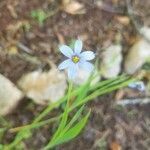Erect, 1–4 dm, delicate and wiry, dark green, drying dark; stems very slender, up to 1(–1.5) mm wide, barely or scarcely winged, entire-margined; lvs entire, very narrow, the larger ones up to 1.5 mm wide; spathes mostly solitary at the summit of the simple stem, often geniculate (set at an angle to the stem), anthocyanic or rarely green, the outer bract somewhat foliaceous and with its margins connate near the base, the inner bract shorter, 1.2–2 cm; tep 8–10 mm, bright violet (white); fr 2–4 mm; 2n=32. Meadows, fields, sandy places, and woods; Me. and w. Mass. to Ont. and Man., s. to N.C., Mich., and N.D.
A herb that forms clumps. The stems are flat or 2 sided. The leaves are 1-2 mm wide. The capsules are 3-4 mm long.

